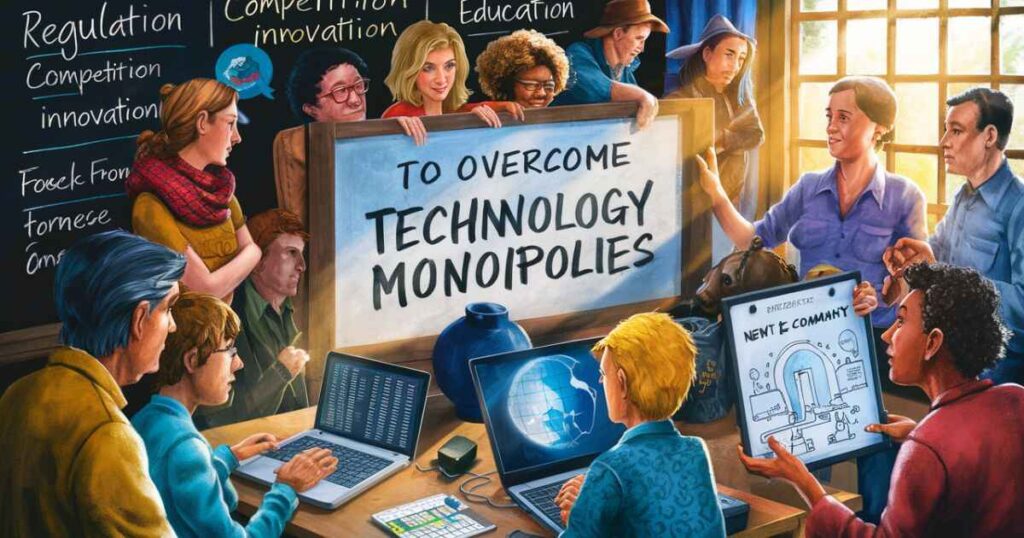A technological monopoly occurs when a single company dominates the market with its advanced technology. It sets up a certain product or a service that is hard for other firms to come and compete for with it. Their technology dries up the market hence becoming a benchmark that other players cannot easily overcome.
What Is Technological Monopoly? Just suppose that there is one dominant company controlling all the events in the sphere of technologies. Their innovations are path setting, and anything that other people come up with is never as good as that. It can make the price to be high and the choice to be limited for the consumers, voters, or end users.
Technological monopolies have mostly begun from inventions that gave a group of people or company an edge over others. Businesses spend a lot of money on research and development. They get patents for their inventions and make their positions stronger in the market. While these monopolies stimulate innovation, they also bring problems to competition and consumer options.
Understanding Technological Monopoly

To really grasp the concept of a technological monopoly, let’s break it down. Imagine you’ve invented a revolutionary new way to produce energy-efficient light bulbs. Your method is so advanced that no one else can replicate it without infringing on your patents. Congratulations! You’ve just created a technological monopoly.
This type of monopoly arises when one company exclusively controls the technology essential for a particular product. This control can be over:
- Production methods
- Intellectual property rights
- Essential components or materials
The result? A significant market advantage for the monopolist. Consumers might face fewer choices and potentially higher prices due to reduced competition. It’s like being the only person with the recipe for the world’s best chocolate chip cookies – everyone has to come to you if they want a taste.
Impact on Innovation:
You might think that with all their resources, technological monopolies would be hotbeds of innovation. Sometimes, that’s true – after all, who else can afford to pour billions into R&D? But there’s a flip side to this coin.
Technological monopolies often cause a decrease in industry-extensive innovation. With manipulation over an important generation, a monopoly can save you from different companies from coming into the market. This reduces opposition, which is generally a number one driver of technological advancement and decreases fees.
“opposition isn’t the handiest basis of protection to the client, however it is the inducement to progress.” – Herbert Hoover
When a single company holds a monopoly, it might not push for new developments as aggressively. This complacency can hinder the advancement of technology, leaving consumers with outdated or less efficient products. The broader economic implications can significantly affect job creation and technological dynamism.
Consumer Effects:
The direct impact of technological monopolies on consumers can be substantial. Typically, these monopolies lead to:
- Higher prices: With no real competition, why lower prices?
- Fewer choices: It’s the monopoly’s way or the highway
- Reduced innovation: Less pressure to improve products
- Increased dependency: Consumers become locked into one ecosystem
A monopolistic firm has little reason to lower prices or improve its offerings without competitors. Moreover, consumer dependency on a single technology or provider increases. This can lead to service, support, and satisfaction issues, as consumers have limited alternatives.
The market dynamics shift from consumer-driven to producer-driven, altering how products and services evolve. It’s like being stuck in a restaurant with only one item on the menu – you’ll eat it, but you might not be thrilled about it.
Regulation Challenges

Regulating technological monopolies is no walk in the park. Government oversight must balance fostering innovation with preventing market dominance that can harm consumers and the economy. This involves intricate legal and economic assessments to ensure fair competition is maintained.
Some key challenges in regulating tech monopolies include:
- Rapid technological change: Laws struggle to keep up with tech advancements
- Global nature of tech companies: Different countries have different regulations
- Complex business models: It’s not always clear where the monopoly lies
- Powerful lobbying: Tech giants have deep pockets to influence policy
The dynamic nature of technology markets makes it difficult to predict and manage the long-term impacts of these monopolies. Regulations must evolve constantly to keep pace with technological advancements, making the regulatory process complex and ongoing.
Types of Monopolies
While we’re focusing on technological monopolies, it’s worth noting that they’re not the only game in town. Each type of monopoly presents its own set of challenges and benefits to society. Technological monopolies are particularly intriguing because they often arise in rapidly evolving industries where today’s monopoly could be tomorrow’s has-been. Let’s break down the different types of monopolies:
- Natural Monopoly: Occurs in industries where infrastructure costs are so high that it’s more efficient for one provider to serve all customers (e.g., utilities).
- Government Monopoly: Created by the government granting exclusive rights to produce or supply services (e.g., postal services, railways).
- Technological Monopoly: Arises while an employer controls the technology vital to provide a specific product, giving them dominant market manipulation.
- Geographic Monopoly: Exists when a company is the sole product or service provider in a specific geographic area, typically due to a lack of economic viability for competitors.
How Can Technology Affect Monopolies?
Technology can significantly impact monopolies in various ways, both reinforcing existing monopolies and creating opportunities for new ones. In industries where network effects are strong, such as social media or operating systems, technology can lead to a “winner-takes-all” scenario.
The company that gains an early technological advantage can quickly dominate the market, making it difficult for competitors to enter. Additionally, proprietary technologies and patents can create barriers to entry, allowing a company to maintain its monopolistic position.
On the other hand, technological advancements can also disrupt existing monopolies. Innovative startups can introduce new products or services that render old technologies obsolete, potentially toppling established monopolies. For instance, the rise of streaming services has challenged traditional cable TV monopolies.
How to Overcome Technology Monopolies?

Overcoming technology monopolies requires a multi-faceted approach involving regulatory action, market-driven solutions, and consumer awareness. Governments can implement and enforce antitrust laws to prevent excessive market concentration and abuse of dominant positions.
This may include breaking up large tech companies, prohibiting certain anti-competitive practices, or mandating interoperability standards to level the playing field. Additionally, regulators can promote policies that encourage innovation and competition, such as supporting open-source initiatives or providing incentives for startups and small businesses in the tech sector.
Market-driven solutions also play a crucial role in challenging tech monopolies. Competitors can focus on niche markets or develop innovative products that offer unique value propositions to consumers. Emphasizing privacy, security, or ethical practices can attract users who are dissatisfied with dominant platforms.
Examples of Technology Monopoly
- Microsoft Windows: Dominated the personal computer operating system market for decades.
- Google Search: Controls a vast majority of the global search engine market.
- Amazon: Near-monopoly in e-commerce and cloud computing services (AWS).
- Facebook (Meta): Dominates social media with its main platform and subsidiaries like Instagram and WhatsApp.
- Apple: Monopolistic control over its iOS app ecosystem.
Global Influence
Technological monopolies don’t just stay in their home countries, they extend their influence globally. This vast influence raises questions about global economic equity and access to technology. As these monopolies expand, they can significantly impact how different parts of the world adopt and use technology. These tech conglomerates often control significant portions of international markets, allowing them to:
- Set standards across industries
- Influence technological developments worldwide
- Shape global market trends
- Impact technological accessibility in developing countries
Conclusion
Technological monopolies shape industries through control of critical technologies.They often hinder competition and reduce consumer choices. Monopolies can lead to higher prices for consumers. These giants drive significant advancements in their fields. They challenge the concept of market fairness.
Regulatory bodies must enforce laws to encourage competition. Preventing market domination by a single entity is crucial. Effective regulation can help innovation thrive. A balanced market benefits the entire economy. Consumer choice is enhanced in a competitive environment.
Frequently Asked Questions
What is a technological monopoly?
It’s when one firm controls the technology or methods to produce a product.
How does a technological monopoly affect consumers?
It could cause higher costs and less picks.
Can technological monopolies stifle innovation?
They are able to restrict competition and gradually reduce innovation.
Are there any famous examples of technological monopolies?
Businesses like Microsoft, Apple, Google, and fb are examples.
How can technological monopolies be regulated?
Governments can enforce antitrust laws to promote competition.

